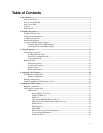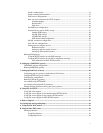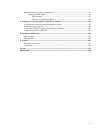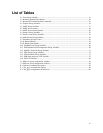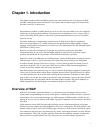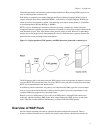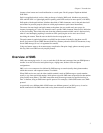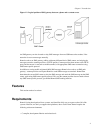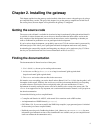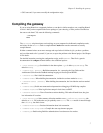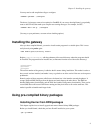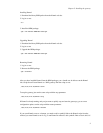Chapter 1. Introduction
This chapter introduces WAP and SMS in general terms, and explains the role of the gateway in WAP
and SMS, outlining their duties and features. It also explains why the Kannel project was started in the
first place, and why it is open source.
With hundreds of millions of mobile phones in use all over the world, the market for services targeted at
mobile users is mind-bogglingly immense. Even simple services find plenty of users, as long as they’re
useful or fun. Being able to get news, send e-mail or just be entertained wherever you are is extremely
attractive to many.
The hottest technology for implementing mobile services is WAP, short for Wireless Application
Protocol. It lets the phone act as a simple web browser, but optimizes the markup language, scripting
language, and the transmission protocols for wireless use. The optimized protocols are translated to plain
old HTTP by a WAP gateway.
Kannel is an open source WAP gateway. It attempts to provide this essential part of the WAP
infrastructure freely to everyone so that the market potential for WAP services, both from wireless
operators and specialized service providers, will be realized as efficiently as possible.
Kannel also works as an SMS gateway for GSM networks. Almost all GSM phones can send and receive
SMS messages, so this is a way to serve many more clients than just those using a new WAP phone.
In addition, Kannel operates as Push Proxy Gateway , or PPG, making possible for content servers to
send data to the phones. This is a new type of WAP service, and have many interesting applications.
Usually servers know whether some data is new, not the users.
Open Source (http://www.opensource.org) is a way to formalize the principle of openness by placing the
source code of a product under a Open Source compliant software license. The BSD license was chosen
over other Open Source licenses by the merit of placing the least amount of limitations on what a third
party is able to do with the source code. In practice this means that Kannel is going to be a fully-featured
WAP implementation and compatible with the maximum number of bearers with special emphasis on
SMSC compatibility. The Kannel project was founded by Wapit Ltd in June, 1999.
Overview of WAP
WAP, short for Wireless Application Protocol, is a collection of various languages and tools and an
infrastructure for implementing services for mobile phones. Traditionally such services have worked via
normal phone calls or short textual messages (e.g., SMS messages in GSM networks). Neither are very
efficient to use, nor very user friendly. WAP makes it possible to implement services similar to the World
Wide Web.
Unlike marketers claim, WAP does not bring the existing content of the Internet directly to the phone.
There are too many technical and other problems for this to ever work properly. The main problem is that
Internet content is mainly in the form of HTML pages, and they are written in such way that they require
fast connections, fast processors, large memories, big screens, audio output and often also fairly efficient
input mechanisms. That’s OK, since they hopefully work better for traditional computers and networks
that way. However, portable phones have very slow processors, very little memory, abysmal and
1






